Three Metal Amulets: Descriptions and Translations
First Published: 2008-01-18
Last Modified: 2008-01-18
The following three silver amulets were purchased by the author in the mid-1990s from an antiquities gallery in New York. The translations and probable origins of these pieces are to the best of the author’s knowledge based on personal research. You might wish to compare the content and order of content of these amulets with Budge, Trachtenberg, and Shrire's ideals of the "typical" amulet.
Amulet #1: Protective
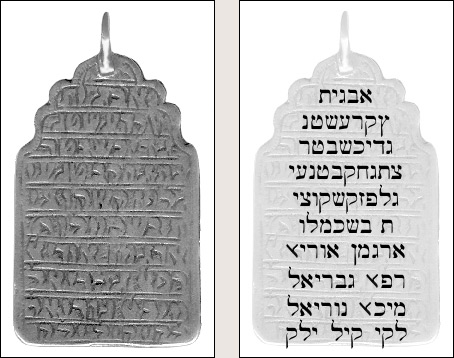
- Size: Size: 2 3/8" from top of loop to bottom, 1 5/16" wide, a little more than 1/32" thick.
- Metal: Silver
- Shape: Elongated pentagon with scalloped top edges and a thick loop.
- Ornamentation: Single line border around all type with remains of zig-zag hatching outside the border; two lines separating each line of text; small tic-marks separating most phrases or words.
- Type Style: Stylized block letters defined by having their outlines incised into the metal.
- Reverse: Blank, flat and smooth.
- Probable Origin: Uncertain; Persia (Iran), Kazakstan or Herat.
- Probable Date: 19th century
This is a very solid piece of metal whose most remarkable feature is its writing style, which initially made it hard to read. With a little patience and comparison to printed text, its message gradually became clear.
Translation and Interpretation: The character resembling a backward lower-case Y is an archaic one representing the suffix "-el", in this case used in some of the occurrences of the names of angels. This character, according to Schrire, was popular in Kazakstan or Herat, which produced amulets similar in style to those of Persian origin. The type style on this amulet corresponds to a Persian example documented by Schrire, though the use of what appears to be the "-el" character may indicate another origin.
The first six lines and the first (rightmost) character of the 7th comprise the 42-letter Name, minus a final nun which should appear in line 2. The rest of the seventh line contains an abbreviation for the phrase Baruch Shem Cavod Malkhutov Layolam Va'ed, "Blessed be His Glorious Name Forever and Ever." The eighth line starts with Argaman, a mnemonic for the names of the archangles, which fill the rest of the eighth, ninth, and tenth lines: Uriel, Raphael, Gabriel, Michael, and Nuriel. The final line contains three permutations of an abbreviation formed from the initial letters of Genesis 48:18: "I wait in hope for your deliverance, O God!"
Given the nature of the Biblical verse and the use of the 42-letter Name to dispel evil, I surmise this amulet calls on the highest powers of good for protection.
Amulet #2: Something for Mother
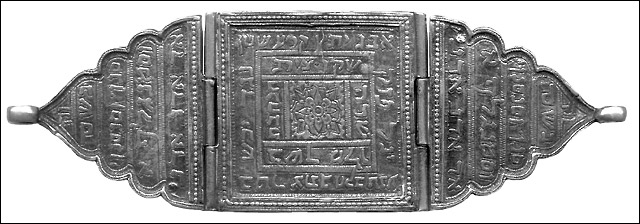
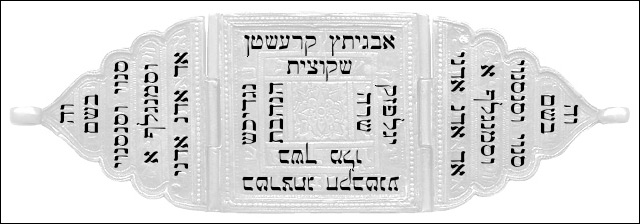
- Size: 6" long from loop tip to loop tip, 1 7/8" wide at broadest point.
- Metal: Silver
- Shape: Almost square center piece flanked by two scalloped triangles. The three pieces are connected by hinges. At the point of each triangle is a short, thick loop.
- Ornamentation: Fine raised-beaded and multi-line raised border around the center square and above the hinges; raised border with incised dots around scallops; double line border filled with hatching between each line of text; stlyized flower in center quare.
- Type Style: Easy-to-read block lettering in low relief (it appears to be embossed) with incised outline.
- Reverse: Blank, with an apparent reinforcement in the center section, and a ghosting of the characters where they were apparently pushed out from the back.
- Probable Origin: Persia (Iran)
- Probable Date: 19th century
This is a wonderful, very substantial metal piece made to be tied to the arm (note the hinges and the loop at either end). The "wings" are identical, and look like they were cast from the same mold.
Text:
Triangular wings:
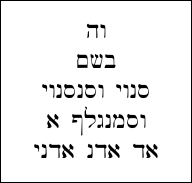
Square panel, around the outside perimeter:
Square panel, inside top:
Square panel, inside bottom:
Square panel, inside left:
Square panel, inside right:
Translation and Interpretation: Wings: The top line, containing VH (vav hey), simply seems to be part of the Tetragrammaton. The next three read, "In the name of/Sanvi, and Sanasanvi/And Smengelef". After Smengelef we find the letter aleph, and the line below builds up the Name Adonai: A, Ad, Adon, Adonai.
Square: The outside border of the square panel, and the top of the inner square, contain the 42-letter Name of God. The bottom of the inner square contains the abbreviation for Baruch Shem Cavod Malkhutov Layolam Va'ed, "Blessed be His Glorious Name Forever and Ever." The third character of the acronym is a kaf sofit, a final kaf, which is a variation of the Hebrew character used at the end of a word. his is odd and probably a minor error since the kaf in the acronym should represent the first letter of Cavod. It may be because the acronymn is broken into two segments, making it appears as if it is two words, one ending in kaf. To the left and right of the flower in the center is the phrase, Hannah bat Sara, which means "Hannah, daughter of Sara."
This is clearly an amulet for a woman to use during and shortly after childbirth, as Snavi, Sanasanvi, and Smengelef are the three angels who ward off Lilth, queen of the demons, an entity responsible for killing newborns and sometimes new mothers (among other things). The Name of 42 letters, as mentioned previously, was popular for warding off evil. I'm excited that this piece provides us with just a hint of its past: Hannah would have been the owner. Notice that she is identified in terms of her mother; this was the norm for formulas used in practical Kabbalah.
I wonder how Hannah and her children did.
Amulet #3: Fake or Mistake?
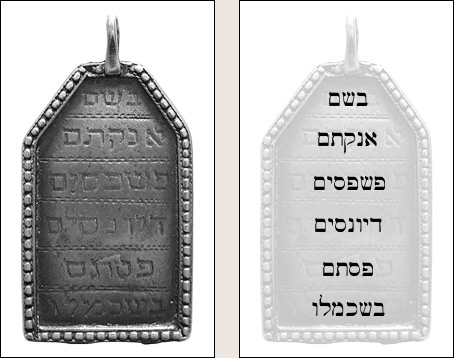
Let's examine our third amulet, the first one I obtained. It was sold to me described as "Jewish Talisman (made of silver). Hebrew writing, prayer for protection. 17th Century."
- Size: 1 3/4" high from bottom to loop tip, 7/8" wide, about 1/32" thick.
- Metal: Silver (of lesser quality)
- Shape: Elongated pentagon.
- Ornamentation: Raised border with round beads; double incised dotted line between lines of text.
- Type Style: Engraved square-style characters which seem to be made out of closely-spaced tics.
- Reverse: Blank, a little lumpy.
- Probable Origin: Uncertain; possibly Kurdistan, based on text and border style.
- Probable Date: 17th (?) century, possibly to 19th century.
Translation and Interpretation: The first line, right to left, bet shin mem), is B'Shem, meaning, "In the name of..." The last line, right to left, bet shin caf mem lamed vav), is an abbreviation of the phrase, Baruch Shem Cavod Malkhutov Layolam Va'ed, "Blessed be His Glorious Name Forever and Ever."
The middle four lines represent the 22-letter Name of God. But there's a hitch. It's misspelled, and out of order. It should read:
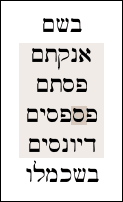
Compare this to the order of the segments on my amulet:

The misspelling occurs in line 4 of the amulet. The correct spelling is:
My amulet reads:
There are two letters in the Hebrew alphabet which represent "S", a samech and a sin. The samech is the correct letter. My amulet bears a sin (the second letter in from the right).
Is this simply a mistake? Or, since it represents a Name of God and one of things Kabbalists did was letter permutation on the Names, do the out of order segments not matter? Was the amulet created by someone who copied it incorrectly, was not learned...or not Jewish? (Apparently some Christians went in for this stuff.) There's no way to know. It could be a modern forgery...but someone like me is not equipped to tell. And why would someone bother to fake something relatively obscure?
Another issue disturbed me. After buying the amulet, I received the next installment of the dealer's catalogue, and saw it still listed. I called and asked, "Is this piece available?" Yes, they said, they had several. I asked how that could be since I expected something of this age and nature to be more or less unique. The dealer simply told me they'd purchased a small lot of them (4-5), and offered little other explanation. This dealer had been in business for over 20 years at the time, and I'd seen them written up in magazines, so they seemed reputable.
Whatever the case, the amulet intrigued me, and so I've kept it. And the story doesn't quite end there, because while it may be a mistake, it may not be fake.
In his exceptional book, Hebrew Amulets: Their Decipherment and Interpretation, T. Schrire dedicates a chapter to the "Background and Description of Silver Amulets", as well as commenting on engraved amulets elsewhere. Schrire studied over 1000 amulets in the process of writing his book, and this is what he has to say:
- "We know very little about the actual engravers of the metallic amulets. They were probably journeymen carrying out the instructions of a superior..." (p. 19) Journeymen, hence non-expert and fallible.
- "The [Jewish] silversmiths, worthy people though they undoubtedly were, do not appear to have been particularly learned in Talmudical or Kabbalistic lore, and even their ability to copy inscriptions with exactitude and accuracy could not always be counted upon....the student [of the study of amulets] has to make allowances for wrong spellings, for omissions of words or groups of letters..." (p. 23-24) Since the common individual who believed in the power of amulets was more than likely also not a scholar of the Kabbalah, they were probably not aware of such mistakes.
- "...[the] silver itself, of a debased quality (probably 75% at its best)..." (p. 24) I took my amulet to a goldsmith. Silver it is, sterling it is obviously not. It tarnishes a nice shade of matte black.
- Schrire lists the shape and style of my amulet as one of six common types: "Pentagonal: Rectangular with the upper boarder carried to a point, and often scalloped so that they look like small minarets. They are fitted with one or two loops at the apex..." (p. 25)
- Schrire writes, "The relatively ignorant engraver of amulets was apparently very prone to error in his work. The fact that so many mistakes are encountered suggests that the artisan or craftsman either copied out inscriptions which he did not understand or else that he engraved them from memory. He was clearly not aware of the origin of the...[things] he was engraving so that he frequently made mistakes and was unable to detect them." (p. 85) Shrire goes on to cite a misspelling example in which he suggests the engraver never saw the words in written form, but wrote what was dictated to him (p. 86), as if you were to hear a word in English and not know whether to use C or K—much as in my case someone has mixed up two characters used to represent S. Hebrew was not the vernacular for the majority of the people who made these amulets, especially those in Europe. In addition to Schrire's book, Joshua Trachtenburg, in his translations of amulets, notes the occasional spelling error (ch. 10, Jewish Magic and Supersition, 1939). By contrast, Shrire notes, surviving amulets written on parchment, which as previously discussed required special preparation and a ritually pure scribe—very similar to Torah production—bear relatively few errors and are "works of art" (p. 87). His belief is that these amulets were written by the true masters.
- Shrire indicates that the engraver went to work on a blank amulet, after it was entirely completed, including the loop. (p. 24) If this is the case, it seems entirely reasonable that a silversmith would cast a number of blanks from the same mold...and then the same engraver could copy the same error onto each one.
My personal conclusion is, I'm inclined to give this amulet the benefit of the doubt. Based on available information, it seems reasonable that it was a common object, one of a batch of such things made by a somewhat inept (but hopefully well-intentioned) silversmith, a batch which, for whatever reason (perhaps discarded for their errors), found its way from the Middle East into a New York gallery. Or maybe I'm a sucker. In the end, owning it has caused me to learn more than I originally thought I ever would. And as I've tried to demonstrate elsewhere, knowledge is power.
Suggested Reading
If you enjoyed this article and want to learn more, I recommend:
Savedow, Steven. Sefer Rezial Hemelach (The Book of the Angel Rezial). Samuel Weiser, Inc., 2000. Full Listing »
Scholem, Gershom. Kabbalah. Keter Publishing House Jerusalem, Ltd., 1974. Full Listing »
Budge, Sir E. A. Wallis. Amulets and Superstitions. Dover, 1978. Full Listing »
Naveh and Shaked. Amulets and Magic Bowls: Aramaic Incantations of Late Antiquity. Magnes Press, Hebrew University, Jerusalem, 1985. Full Listing »
Schrire, T. Hebrew Amulets: Their Decipherment and Interpretation. Routledge and Kegan Paul, London, 1966. Full Listing »
Trachtenburg, Joshua. Jewish Magic and Superstition. Atheneum, 1987. Full Listing »
Gaster, Moses. "A Note on 'A Hebrew Amulet'", presented in Studies and Texts in Folklore, Magic, Mediaval Romance, Hebrew Apocrypha and Samaritan Archaeology, vol. 1. Maggs Brothers, London, 1925-1928. Full Listing »
For more titles on this and other topics, you may also wish to browse my annotated biblography for listings of all of my source texts, including descriptions and brief reviews.

